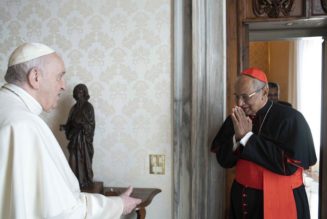
Ask yourself – if my organization (e.g., parish, diocese, school, apostolate, etc.) has done some kind of long-range or strategic planning, did it help significantly impact the organization in a positive way? If not, then why not? Was there institutional renewal? Can we say that the planning process helped change our culture? Most Catholic leaders who have been through these processes in the last few generations would say they have not significantly helped, even if it was a positive thing to do. The Church continues to lose Catholics as more and more institutions go through long-range strategic planning processes.
I have been a part of several of these efforts helping various kinds of Catholic institutions. Some efforts have had some good outcomes, but the long-range outcomes failed to significantly change the culture of the organization, even if there were some short-term wins. The statistical evidence tells us that most strategic planning puts a lot of time, money, and effort into the process, which ends up barely moving the needle for most Catholic organizations. We will explore why below and how we might improve these processes.
Before I go further, I want to say that I am a big fan of long-range planning. I think it is helpful and necessary for any organization that wants success. But, HOW we do it matters as much as whether we do it or not. In fact, if we don’t do a good job at long-range strategy and planning, it can lead to fewer leaders who want to spend the resources doing it, which entrenches us into the problems we currently have. Before we talk about improving the process, let us talk about some principles that need to inform our planning.
WHY WE DO WHAT WE DO
Why does the Catholic Church exist? The answer to this question gives us our mission. Our “why” can be written out as – “We [our institution – in this case, the Catholic Church] exist in order to ______.” Here is the good news, the mission of Jesus, his disciples, and his Church has been given to us, so we don’t need to re-write it or discover it!
Mission of the Church –
- “Jesus came and said to them, “All authority in heaven and on earth has been given to me. Go therefore and make disciples of all nations, baptizing them in the name of the Father and of the Son and of the Holy Spirit, teaching them to observe all that I have commanded you; and lo, I am with you always, to the close of the age.”” -Matt 28:18-20
- “And he said to them, “Go into all the world and preach the gospel to the whole creation. He who believes and is baptized will be saved; but he who does not believe will be condemned.” -Mark 16:15-16
- “But you will receive power when the Holy Spirit has come upon you, and you will be my witnesses in Jerusalem and in all Judea and Samaria, and to the end of the earth.” -Acts 1:8
- “”Henceforward the Church…receives the mission of proclaiming and establishing among all peoples the Kingdom of Christ and of God, and she is on earth the seed and the beginning of that kingdom.” -CCC 768
—The Church exists to make disciples of Jesus.
–Disciples of Jesus exist in order to make other disciples of Jesus.
–Thus, every Catholic institution exists in order to make disciples.
- Parishes exist to make disciples.
- Dioceses exist to make disciples.
- Catholic schools exist to make disciples.
- Catholic hospitals exist to make disciples.
- Catholic colleges exist to make disciples.
- Catholic social services exist to make disciples.
Yes, they all have other things to do, but this is THE mission of each of these organizations. We have to start with this principle which give us our “WHY”. From there we can understand what happens when we lose our “why”.
MISSION DRIFT
When we don’t make disciples, we have started to drift from our mission. Mission drift is the natural tendency of an organization to lose its “why” and start doing other things, even other good things. It is the rip current we don’t see. It is the gravity pulling on us that we don’t think about. It is found in the momentum of culture both outside and within our institutions. We see this when a Catholic college or school starts to focus on the academic reputation as a school, rather than making disciples. It happens when a social service organization tamps down their Catholic identity in order to not cause waves with donors. We see it when a parish worries more about the involvement than in conversion of non-disciples. Dioceses can drift from their mission when they get caught up in the nuts and bolts of handling mergers of parishes, budgets, buildings, and the like. Mission drift is real and has infected every part of Catholicism in the West. It is (in large measure) a way in which we can understand how we got into the current state of decline we are in.
Mission drift can and will happen to every group, unless it is consciously and consistently fought against. It is countered by a persistent clinging to the core of the mission. Because many generations of Catholics have not countered mission drift, we are in a season of rapid and tangible decline.
Did you know that Oxford, Harvard, Yale, and Princeton (among other schools) all began as explicitly Christian institutions? To this day, Princeton’s crest reads “Dei sub numine viget,” which means “Under God she flourishes.” Not so much anymore.
Think of Catholic Universities that have lost their religious fervor. Think of the crisis of identity that many Catholic hospitals have undergone. Think of the parish who has watched people walk away and doesn’t know how to stop the bleeding. For some of these there is no going back. Princeton will never go back to being a Christian institution. Some parishes are already closed down. This is a one-way street. Now, there is a chance for those organizations who haven’t completely lost their way. We see it in the renewal that happened at Franciscan University at Steubenville. Through the 60s and into the 70s they had issues with Catholic identity, money, and vision. Fr. Michael Scanlan was assigned and decided to start the very difficult process of not only stopping the mission drift, but renewing the school. It took many decades of very difficult work. It took clarity around “WHY” the school existed. It was hard and long.
PLANNING, STRATEGY, AND STRATEGIC PLANNING
Fr. Jaime took over Our Lady of Victory Parish in 2002. He had been ordained for 8 years and loved being a priest. This was his third assignment and second as a pastor. He had only been pastor at his previous parish for 3 years. OLVP was ripe for renewal. They had a few good programmatic elements, but little long-term vision. They ran a soup kitchen, had a parish retreat system in place, and a good youth program. After his first year on board, Fr. J felt like he had a good handle of the parish and started making some needed changes. He shut down a few social events that took a lot of resources, but little outcomes to fulfilling their mission. He started to cast a vision for evangelization and outreach. He led his staff and lay leaders in prayer times like they never experienced before.
Then they went through a strategic planning process. They hired a firm that had a good national reputation. The consultant surveyed the parish over the next 6 months, then presented the findings to the leadership of the parish. It had some insightful tidbits of information. From this data, the strategic planning committee started to develop a long-range plan. At the end of the process there was a 5 year plan of renewal that included hiring a few new positions, increasing the budget, starting some new initiatives, and possibly building a new R.E. wing. It all seemed so hopeful.
Flash forward to 2010. Fr. Jaime pulls the plan up on his computer and realizes that the process barely made a dent in his parish. He asks himself – “what happened?” and has no answer. It all seemed so good at the time and we worked so hard (and paid a lot of money for it). He is frustrated and deflated. He desires fruit so badly and is unsure how to move forward. Some bitterness begins to set in.
This story is fiction, but like so many other stories it bears truth. The results of many long-term strategic planning processes are found in libraries and gigabytes worth of documentation that show they have had little (if any) long-lasting impact when it comes to changing the culture of most Catholic institutions. Why? I have 3 reasons:
3 Reasons Catholic Strategic Planning Fails
1 – Culture eats strategy for lunch (and breakfast)! Culture is the strongest human force your parish (or any organization) must overcome in order to lead it toward renewal. Stronger than mission, vision, strategy, goals, or values. “Culture eats strategy for breakfast,” is famously attributed to the late management guru Peter Drucker. Put another way, “parish culture is more powerful than any plan”. It holds true in every circumstance. Now, this isn’t to say that by our cooperation with God’s grace we are incapable of renewing culture. But, as we will see, it is very long and very hard work. Before we go further, we must be clear as to what culture is.
Culture states emphatically – ‘This is how we do things in this place and time” and “This is the way we expect things to be done”. Culture has its own momentum that needs no further energy or input to keep it going. It just exists naturally in every group of people. Culture causes mission drift (as seen above). It is found in the habits of the people in the group, the language, the things that aren’t talked about (as much as what IS talked about), the expectations, the values, the rules, the attitudes, and more. Thus, culture defines the unwritten way that a group of people behave. It serves not merely as the undercurrent, but the prevailing force (for good or bad or both) that the group lives in and expects.
Every parish has a unique culture and is never just like any other parish, even though they may share some of the wider traits of the larger Catholic culture. As with any other organization, parishes start to form their culture from the moment they are formed, yet it will change through the years and never remain completely the same through time. A parish will continue to form culture by drifting into the rules that define it, rather than by intentionally forming it themselves, unless they are intentional about shaping it themselves. Parish culture becomes the by-product of the things we do, say, and believe – esp. those things that are considered “normal”.
If you merely set out a plan thinking that a plan is enough to change culture, your plan will merely be absorbed into your culture – for good or bad.
2 – Culture change is hard and slow work. Culture change is very difficult. It takes good leadership that is intentional, strategic, long-term, and sustained to revitalize our parishes. But even good leadership is not enough by itself.
In an age of growing compartmentalization of personal faith, parishes are aging and declining rapidly. The numbers are staggering. We lose 6 people for every 1 new Catholic. But, that doesn’t tell the full story. During the last few generations, it seems the Church asks less and less of Catholics. Our parishes reflect these changes and many times our parishes are set up to reward mediocre Catholicism. Mediocre Catholics are only able to perpetuate the current state of affairs or advance the mission drift. This is the state of our current parish culture in the USA. Are there exceptions to the norm? Absolutely. But, they are still not the norm. Culture is found in the norm.
Then there are the other obstacles that a parish faces in the attempt to change the culture. The Pastor is reassigned. Staff are laid off and programs cut because money is down. Ineffective leadership doesn’t know how to turn things around, so they depend on what has worked a generation (or several) ago. Unresolved conflict is in the marrow of the parish and is never explicitly dealt with. The entrenched lay parishioners push back because they are not bought into the vision of renewal. Etc. Etc. Etc.
From our current vantage point, things may look bleak. But, let us open up a window and let some light in.
We can positively change the culture of our parishes. It has happened before, is currently happening, and will happen in the future. The question is – will we help in the process of renewal or be an agent of maintaining mediocrity / managing decline?
Sometimes the consultants get us excited, but after they leave, what we most often have is a plan with numerous goals (what), not necessarily a long-term strategy (how).
3 – We confuse goals / plans with strategy. This is a major issue. Strategy is the HOW we achieve our mission and vision (the process of success). Planning is the WHAT we need to get done. When we skip from mission/vision to planning/goals, we forget an important step – strategy.
Strategy focuses on an outcome you desire and why you desire it. Another way to think of strategy is it is the process in which you achieve your mission/vision.
To set a goal of increasing Mass attendance isn’t a strategy. Numbers, objective metrics, etc. are the results of strategy, not strategy itself. In sports, it is easy to understand what a strategy is for, which is to beat the other team. In business the goal is to make more money than your competitors. In ministry, we have to massage the definition a bit. First of all, to win is still to beat the enemy (Satan and his minions) and to do so we win souls for God. In other words, our goal is to get people to heaven. That is how we “win” in Catholic ministry. Yet, strategy goes beyond this. It devises a plan on HOW we win.
Strategy has angst or nervousness with it. It deals with unknown (but hoped for) outcomes sometime in the future. We invest time, effort, and make decisions to get there. Strategy demands trade-offs. You have to give something up to be able to do other things. A parish that wants to reach the unchurched who never come to the parish, can’t just run more programs at the parish and expect people to show up. Thus, they will have to stop doing some things in order to reallocate their time, money, and people into other things.
Strategy is found by having a vision that fulfills your mission. Strategy is achieved by planning.
WHY then WHERE then HOW then WHAT.
Plans are easily doable. Strategy is theoretical. But, we don’t stay in the theoretical, but make it practical (via planning based on a strategy). Strategy (how) needs a logic (why). We ought to ask – what would have to be true about our culture, our world, our strategy – for this vision to work? It necessitates that we change a strategy when we bump into realities that prove our assumptions were wrong.
For it to be accomplished you have to be able to take it from theoretical to doable. Thus, you need to make your theory simple, doable, and clear.
To be able to do planning, you don’t need these things. It is usually siloed “to do” lists that each person (or department) wants. In a dioceses planning process you get groups that want different things and plans are made to get there. So, the Catholic schools offices wants more diocesan support, the Catechetical office needs 4 new computers and a new elementary school curriculum approval process, the chancellor wants a new roof on the office building, etc.
There is no internal clarity or unity to the planning nor is there a collective goal for the whole organization. Thus, it lacks strategy. It is merely a list of goals and plans.
Planning takes over because it is easier, more achievable, gives us the sense that we are accomplishing something, and comes from a culture of getting things done, rather than achieving long-term visionary (and centralized) goals. Planning also comes out of controlling costs, which can more accurately be known and then planned around. Thus, it is about the ones doing the planning. The ones who will lay out and use the costs. The employees, leaders, or volunteers in your organization.
Strategy focuses on the outcome, not the costs. The focus is on the ones being reached and served. The people that need to be evangelized. The disciples that need to be accompanied and formed into missionaries. It is externally focused.
——————
SUMMARY
To achieve a goal of changing the culture of your Catholic institution, you will need clarity and single-minded devotion to:
- MISSION – WHY you exist
- VISION – WHERE you are going
- STRATEGY – HOW you will get there
2 final notes:
- Strategy should be simply stated. For instance, I like to sum up the role of strategy in simply language, for instance Embrace, Evangelize, Establish, and Empower is a HOW and tells us the basics of a kind of strategy. Of course the details need to be spelled out with goals and outcomes, but the general outline in the strategy is there.
- You will not be able to change culture if you merely rely on programs, events, classes, etc. to achieve your strategy without also having personal growth in pastoral skills in evangelization and in maturing disciples.
Remember – A vision built on Catholic mission drives culture change, not the program, plan, event, curriculum, or idea you use. If you have read this far, then maybe you want the answer to the lingering question – how do we start? Well, there are numerous starting points.
If you are a Catholic leader of an institution and want to have a conversation about how we help Catholic leaders renew their institutions, evangelize the lost, and mature disciples – then please reach out here. God bless.
Join Our Telegram Group : Salvation & Prosperity







